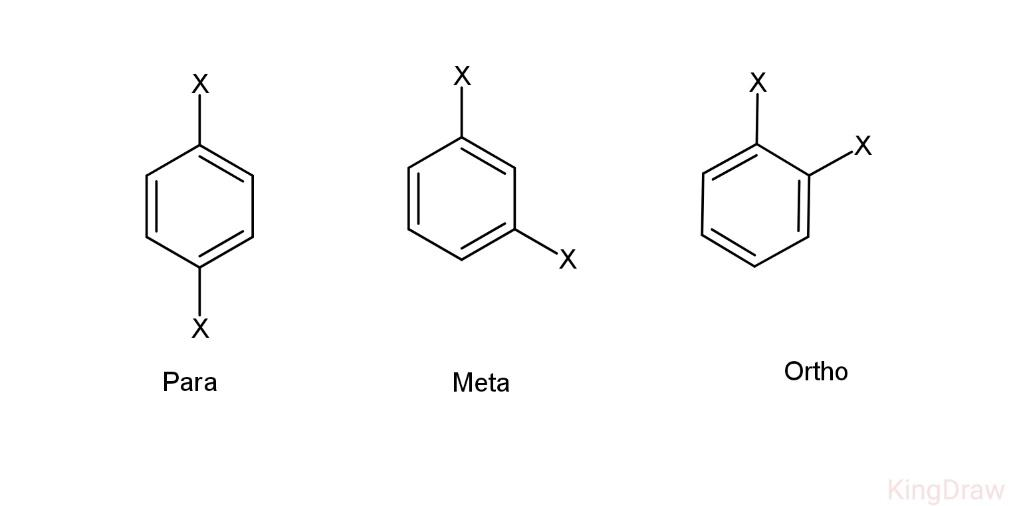
Ortho, meta and para forms of dihalo benzenes are taken in a single container at −25 ${}^\circ C$.The container is slowly heated up to room temperature and after some time it was found that the container was left with a liquid having some solid residues in it. Solid residue can be
(A) ortho form
(B) meta form
(C) para form
(D) mixture of ortho, meta and para form
Answer
486.9k+ views
Hint: The solid residue that remains in the container will be having a higher melting point than the other isomers. We could attempt this question by finding out the relation between the symmetry of these different forms and their physical state.
Complete step by step solution:
- As we know, structural isomers are those molecules that have the same chemical formula but different chemical structures. The three structural isomers of disubstituted benzene rings are named as ortho, meta and para.
- The prefixes ortho (o), meta(m) and para (p) can be used to indicate the relative position of substituents in double substituted benzenes. The relative position of substituents in ortho-substituted benzenes is "1,2", "1,3" for meta-substituted benzenes and "1,4" in para-substituted benzenes.
Examples of dihalo benzenes are 1,2−dichlorobenzene (ortho form), 1,4−dichlorobenzene (para form), 1,3−dichlorobenzene(meta form) , 1,4−dibromobenzene(para form) etc.
The structural representation of these ortho, meta and para forms in dihalo benzenes is shown below. 'X' is the halogen.

-From the above image it's clear that para structures have symmetry. Thus, it can be easily packed into a lattice solid. As a result of this higher packing efficiency, the intermolecular forces of attraction are stronger than the other forms. Therefore, we can see that greater energy is required to break its lattice thereby increasing the melting point of p-isomers.
- The structures of ortho and meta isomer are not so symmetrical like para isomers and they don’t form a close lattice structure.
-Thus, the para form will be having a higher melting point than ortho and meta forms. The solid that will be in the form of residue as given in the question, would be para form since both the other forms would be liquid at lower temperatures than that of para isomer.
- As an example, let's consider the dichloro benzene. 1,2−dichlorobenzene is colourless to pale yellow liquid. 1,3−dichlorobenzene is also a colourless liquid whereas 1,4−dichlorobenzene (para form) is colorless to white solid.
Therefore, the answer is option (C) para form. Para form of dihalo benzene is the one that remains as solid residues.
Note:
There might be a possible chance of confusion between boiling and melting point of these isomers. The melting point order is p-dihalo benzene>o-dihalo benzene>m-dihalo benzene. The boiling point order is o-dihalo benzene >p-dihalo benzene>m-dihalo benzene.
Complete step by step solution:
- As we know, structural isomers are those molecules that have the same chemical formula but different chemical structures. The three structural isomers of disubstituted benzene rings are named as ortho, meta and para.
- The prefixes ortho (o), meta(m) and para (p) can be used to indicate the relative position of substituents in double substituted benzenes. The relative position of substituents in ortho-substituted benzenes is "1,2", "1,3" for meta-substituted benzenes and "1,4" in para-substituted benzenes.
Examples of dihalo benzenes are 1,2−dichlorobenzene (ortho form), 1,4−dichlorobenzene (para form), 1,3−dichlorobenzene(meta form) , 1,4−dibromobenzene(para form) etc.
The structural representation of these ortho, meta and para forms in dihalo benzenes is shown below. 'X' is the halogen.

-From the above image it's clear that para structures have symmetry. Thus, it can be easily packed into a lattice solid. As a result of this higher packing efficiency, the intermolecular forces of attraction are stronger than the other forms. Therefore, we can see that greater energy is required to break its lattice thereby increasing the melting point of p-isomers.
- The structures of ortho and meta isomer are not so symmetrical like para isomers and they don’t form a close lattice structure.
-Thus, the para form will be having a higher melting point than ortho and meta forms. The solid that will be in the form of residue as given in the question, would be para form since both the other forms would be liquid at lower temperatures than that of para isomer.
- As an example, let's consider the dichloro benzene. 1,2−dichlorobenzene is colourless to pale yellow liquid. 1,3−dichlorobenzene is also a colourless liquid whereas 1,4−dichlorobenzene (para form) is colorless to white solid.
Therefore, the answer is option (C) para form. Para form of dihalo benzene is the one that remains as solid residues.
Note:
There might be a possible chance of confusion between boiling and melting point of these isomers. The melting point order is p-dihalo benzene>o-dihalo benzene>m-dihalo benzene. The boiling point order is o-dihalo benzene >p-dihalo benzene>m-dihalo benzene.
Recently Updated Pages
Master Class 12 Economics: Engaging Questions & Answers for Success

Master Class 12 Maths: Engaging Questions & Answers for Success

Master Class 12 Biology: Engaging Questions & Answers for Success

Master Class 12 Physics: Engaging Questions & Answers for Success

Master Class 12 Business Studies: Engaging Questions & Answers for Success

Master Class 12 English: Engaging Questions & Answers for Success

Trending doubts
Distinguish between esterification and saponification class 12 chemistry CBSE

Give five points to show the significance of varia class 12 biology CBSE

How was the Civil Disobedience Movement different from class 12 social science CBSE

India is the secondlargest producer of AJute Bcotton class 12 biology CBSE

Draw ray diagrams each showing i myopic eye and ii class 12 physics CBSE

Give simple chemical tests to distinguish between the class 12 chemistry CBSE




